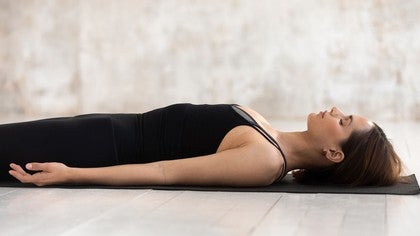
Yoga Breathing 101: Beginner Tips and Practices
Breath is to yoga what water is to a fish: essential for movement and life force. Consider this Sanskrit proverb: “For breath is life, and if you breathe well, you will live long on earth.”
Yet pranayama, the fourth of the Eight Limbs of Yoga, often gets short shrift on the yoga mat. Because it happens unconsciously, we don’t have to think about the breath very often. By bringing attention to the breath, you can balance the mental, physical, and subtle bodies, and open up a whole new realm of possibility and discovery in your yoga practice.
How Should I Breathe During Yoga?
Coordinating your breathing with the teacher’s instruction can often feel confusing, especially when you are new to yoga. Wait, she’s saying breathe in, but I’m exhaling. If your breath isn’t syncing up, you can think of the teacher’s instructions as a general reminder to keep breathing as you move through postures. As a very general rule of thumb, try to exhale as you bend forward and inhale as you open the chest and expand the front body.
Should I Breathe through My Nose?
For the most part, yes. The nose is a natural filter for air, warming or cooling the air before it reaches your lungs and protecting you against the estimated 20 billion particles of foreign matter every day.
And that’s not just on the yoga mat. John Douillard, former professional triathlete and author of Body, Mind, and Sport, has married Eastern and Western traditions in his Ayurvedic and sports medicine practice. In a number of studies, his research has found that breathing through the nose reduced the perceived rate of exertion during exercise, and decreased activity of the parasympathetic nervous system's “fight or flight” mechanism. Meaning when you’re jogging around the reservoir, riding your bike to the farmer’s market, or strength training, try to practice nose breathing, too, and your workout will feel less difficult and more relaxed.
Moreover, if you ever want to let out a big sigh or exhale out of the mouth, always feel free to do that.
How Do I Teach Myself to Breathe?
Breathing is an innate and automatic bodily process, so you’re doing it whether you’re consciously trying to or not, about 23,000 times per day. What you can do, however, is refine and deepen your breathing practice simply by paying attention to it.
Think of it in two parts: Breathe in slowly and deeply through your nose, allowing your chest and belly to expand as air fills your lungs. Then exhale slowly through your nose. Repeat. That’s the basics of breathing.
From there, you may move on to other forms of pranayama practice.
Ujjayi Pranayama
Ujjayi pranayama, or “victorious breath,” sounds a little bit like the ocean. It is practiced by inhaling deeply through the nose, contracting the back of the throat slightly, and exhaling through the nose. The throat should not feel tight.
The steadiness of Ujjayi breath, practiced throughout the flow of asana in a yoga class, anchors body, mind, and spirit to the present moment.
Here's a great Ujjayi breath tutorial from Yoga Anytime teacher, Kristin Leal.
Nadi Shodhana Pranayama or Alternate Nostril Breathing
The yogic promise behind Nadi Shodahana, known as alternate nostril breathing is that it unblocks the nadis, the energy passages that carry prana, or "vital life force energy", through the body. While scientific studies have yet to back this up, devotees of the practice, like any other deep breathing, swear by its calming effects. Alternate nostril breathing is best practiced when you’re not sick or congested.
In a comfortable seated position, place your left hand on your left knee. Raise the right hand to your forehead and place your index finger and middle finger on your third eye. Close the right nostril with your thumb. Inhale through your left nostril. Close the left nostril with your ring finger, and exhale through your right nostril. Breath in through the right nostril, then close the right nostril with your thumb. Breathe out through the left nostril. This is one cycle. Complete for up to five minutes.
What Are the Benefits of Yogic Breathing?
Deep breathing is one of the best antidotes to stress there is. It counteracts stress by triggering the relaxation response. Deep breathing pulls back the reins on the body’s physical stress response including increased heart rate, fast breathing, and high blood pressure. Breathe deeply, and the body receives a message from the brain that all is well — it’s safe to relax. Couple deep breathing with asana (or guided imagery, mantra meditation, or therapeutic massage), and you’ve given your body and mind one of the most effective relaxation techniques there is.
Some other benefits of yogic breathing include:
- Reduced stress, anxiety, and depression.
- Increased calm and relaxation.
- Lowers cortisol in the body.
- Stabilizes and lowers blood pressure.
- Aids with insomnia and sleeplessness.
- Improves core strength.
- Expels carbon dioxide and increases oxygen.
- Helps manage irritable bowel syndrome.
The Bottom Line on Yogic Breathing
Practicing deep yogic breathing through the nose, whether on the mat flowing through a vinyasa practice, meditating, or chilling out at your desk, brings with it a myriad of benefits to the body and mind. One of the things we love about yogic breathing is exactly what we love about the practice of yoga in general: it benefits everybody and is available to everyone, right now.
Comments
No comments yet. Be the first!












You need to be a subscriber to post a comment.
Please Log In or Create an Account to start your free trial.